
FL MORRIS / FMORRIS@STARBULLETIN.COM
The attempt to revitalize and gentrify Honolulu's Chinatown juxtaposes two cultures. While people are still found passed out on Chinatown streets, like the man above seen Friday night along Nuuanu Avenue, the area is courting an upscale crowd.
|
|
Chinatown at a crossroads
Trade-offs loom as the balance shifts from seedy to trendy
LIKE many involved in the budding arts-and-culture revival of the historic Chinatown district, artist Rich Richardson worries about it going too far.
In his worst nightmares, he sees a gentrified zone where Starbucks and big-box retailers have muscled out corner lei stands; where mom-and-pops run by area residents are nudged aside in a "real estate boom for martini drinkers from the financial district."
CHINATOWN SPEAKS
Following are some results from a recent survey about Chinatown, 77 percent of the respondents to which either lived or worked in the area.
Top five suggestions to improve Chinatown:
1. Provide 24-hour restrooms to combat urine smell from homeless.
2. Make metered parking cheaper; install card-reader meters to eliminate coin hassles.
3. Combat drug dealing with increased law enforcement.
4. Improve pedestrian safety at dangerous intersections/crosswalks.
5. Provide financial incentives to landowners to maintain buildings.
Source: March survey of about 350 Chinatown residents by The ARTS at Mark's Garage community outreach.
Tonight on KITV 4 NEWS at 10 ...
Chinatown is not just Chinese anymore. From Vietnamese to Laotians to Filipinos, it hosts other ethnic groups that have their own ideas for its future. Denby Fawcett looks at the issue tonight on KITV 4 Island Television News at 10.
|
"I'd hate to see the momentum run rampant over the people who live and work here," said Richardson, assistant director of arts incubator The ARTS at Mark's Garage, which has played a key part in the revival.
That such fears are now being entertained shows just how far Chinatown has come.
Since the rebirth of the Hawaii Theatre beginning in the 1980s, a revitalization is slowly taking back areas once ceded to drug dealing and prostitution. Hip new galleries and bars now add to the timeless bustle of the area's Chinese core.
The challenge of maintaining that momentum while protecting Chinatown's unique historical, social, ethnic and cultural mix will be taken up at the Hawaii Theatre Thursday at the first "Chinatown Summit," called by Mayor Mufi Hannemann.
"This is an opportunity to bring all the stakeholders together to really take stock of how far we've come and where we're going," Hannemann said. "Chinatown looks a lot better today than it did yesterday. But we need to take it to the next level."
Chinatown indeed seems to be at a crossroads.
Urban renewal efforts typically consist of at least two waves, the first triggered by a single catalyst like the resurrection of the Hawaii Theatre, said Miguel Garcia of the Ford Foundation, which has been involved in reviving urban areas elsewhere and has funneled grant money to support Chinatown's arts expansion.
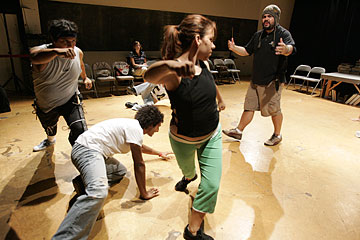
FL MORRIS / FMORRIS@STARBULLETIN.COM
Members of the "Life is a Dream" cast rehearsed Friday for an upcoming performance at The ARTS at Marks Garage.
|
|
The first wave typically spawns a hip, artsy night district, followed by several years in which the real estate market "tries to figure out what to do next," which is where Honolulu is now, Garcia said.
Encouraging that second wave holds great potential benefits for the whole state. Aside from spurring the arts, Honolulu would have an alternative visitor destination to Waikiki and a place for cooped-up cruise-ship passengers to unload some of their cash. But there is a downside.
"It's usually that second wave that creates a tipping point for the whole area, and some small businesses and others are often hurt by that," he adds.
On the bright side, the community is likely to have time to prepare for that wave, which seems unlikely to break soon due in part to indecision in the real estate market.
Nearly everyone involved agrees the area cannot reach its full potential until it attracts more residents who live and work in the area, be they sculptors or Asian shopkeepers. This tends to creates real "communities," rather than areas where the sidewalks are rolled up at night and the streets given over to vice.
The city opened one avenue when it passed an ordinance two years ago allowing rental lofts to be created in the upper floors of Chinatown's historic low-rise buildings.
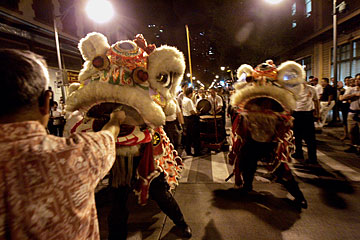
FL MORRIS / FMORRIS@STARBULLETIN.COM
Lion dancers helped bring in the Chinese New Year along Hotel Street in late January.
|
|
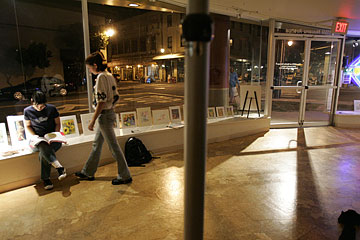
FL MORRIS / FMORRIS@STARBULLETIN.COM
Lauren Asinsen, left, and Stacy Stout, from the cast of "Life Is a Dream," break during rehearsal for an upcoming performance at The ARTS at Marks Garage. The view looks out from the gallery at Chinatown.
|
|
"We need to see a real change in the quality and quantity of housing. We need to increase it and also change it to allow for more extended families to live together, which is the traditional way for Asian cultures," said Wing Tek Lum, whose family operates a real estate investment company.
But landowners see few incentives to go that route, due to the huge cost of bringing aging sewer and electrical systems up to modern codes. Then there's the maze of permitting and other requirements related to Chinatown's designation as a historic district, which also restrict what landowners can do.
"The cost is incredible," said Ernie Hunt, who owns the historic Mendonca Building on Smith Street, built in 1901 and now rented out as office space.
"If you look at the costs of creating lofts, it far outweighs how much you could get in rent," he said, adding that if landowners charged enough rent to recoup the costs, area rents would soar, driving out many residents and businesses.
The Ford Foundation's Garcia said there is an array of grants and tax credits available to address such problems, which Chinatown landowners may not be aware of. These include a historic preservation tax credit that can actually be "sold" to outside corporations or investors for cash that can help finance renovations.
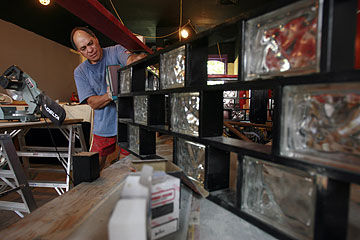
GEORGE F. LEE / GLEE@STARBULLETIN.COM
As Chinatown thrives in some areas, it remains a gathering place for the homeless. On Friday, Hank Taufaasau, left, put the finishing touches on some detailing for a jazz club he is opening soon on Nuuanu Avenue.
|
|
Some are looking to the city to help get the ball rolling by providing city-owned land in and around the area for new housing.
Hannemann, a longtime supporter of Chinatown who talks fondly of eating there and watching movies at its long-gone theaters as a child, said he's open to suggestions from "motivated developers."
"That might be one way to for the city to participate," he said, adding that the city's main role is merely to bring stakeholders together.
"What the city can do for Chinatown is what it did for Waikiki, but without spending billions of dollars. It's about making sure the necessary infrastructure is in place and letting motivated stakeholders run with it," he said.
Lingering drug-dealing, homelessness and aggressive panhandling are other areas of near-unanimous concern.
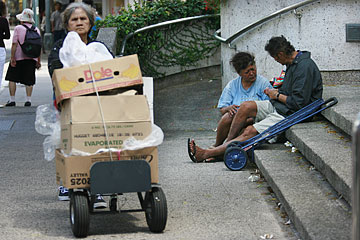
GEORGE F. LEE / GLEE@STARBULLETIN.COM
A homeless couple sat on steps at the corner of Bethel and Hotel Streets.
|
|
Local merchants praise police for paying more attention to the area, but the number of reported crimes actually has grown in recent years, though it eased a bit last year, according to Honolulu Police Department figures.
"We get some of the perpetrators and others move out. But new faces come in," said Sgt. Gary Lum Lee of the Chinatown substation.
The number of free meals handed out each month by the River of Life Mission on Pauahi Street has increased from about 9,000 a few years ago to 13,000 last month, said Shevy Gardner, its director of operations.
"We know we're serving drug addicts and prostitutes. But they're somebody too," she said.
Others in Chinatown would like to see a harder line taken to clean up the streets.
"That's the old Chinatown, the image of homelessness and crime. We have to clean that up. Many other people would love to live or do business there, but things like that are holding them back," said Gifford Chang of the Chinatown Merchants Association.
Bonnie Parsons' tiny fashion accessories shop Bonnie's Closet has a recessed entrance on Nuuanu Avenue favored by shelter-seeking homeless. Almost daily, she has to call the police to remove them or step over the sleeping squatters, who urinate and spit in the area.
"(Shoppers) look in the window like they want to come in, but they see the vagrants and just keep on going," she said.
She had a problem with the homeless people particularly last month, which in turn was a "difficult" one for sales, she said.
The arts revival may offer a solution. Events such as First Fridays and "gallery walks" have brought more desirable foot traffic to the area that, many merchants say, temporarily drives out bad elements.
"As more activity comes, and there is more use of the area's businesses and the theater, the less of a bad element appears. That's just the way it happens," said Sarah Richards, president of the Hawaii Theatre Center.
There is general agreement that the arts revival has led to more instances of cooperation between community factions than disputes.
But the question of how much Chinatown should be cleaned up is shaping up as a key topic for the summit, and is characterized by more than one observer as a struggle between the arts community and Asian merchants.
An overly sterilized Chinatown removes the "edgy" feeling on which vibrant Bohemian districts thrive, said Ed Korybski, executive director of the nonprofit Honolulu Culture and Arts District.
Likewise, gentrification causes rents to climb, driving out the starving artists and hard-working immigrants who make Chinatown tick, arts advocates say.
"We don't want it to become Disneyland," Korybski said.
But Chang argues that too much control could smother needed change. The area's history has been one of change, with first Chinese immigrants, then Japanese and newer Vietnamese and Filipino immigrants contributing to its evolution, he said.
"You can't say 'no change,'" Chang said.
The debate begins on Thursday.

STAR-BULLETIN FILE PHOTO
A photo of the 1886 Chinatown Fire on River Street.
|
|
CHINATOWN: A LOOK BACK
From bloom to seed and back again, Chinatown has come full cycle in the last century and a half.
1852 » Arrival of first contract laborers from southern China marks beginning of large-scale Chinese immigration to Hawaii.
1880s » Chinatown is a bustling mix of markets and eateries, many run by former laborers whose contracts expired.
1886 » A fire spreads through Chinatown's rickety wooden structures, burning for three days, destroying eight blocks and leaving thousands homeless.
1900 » Authorities lose control of fires set in Chinatown deliberately to contain a plague outbreak. Most of the district burns to the ground. Many Chinese residents and merchants leave for good, and the area slips into long decline.
1922 » The Hawaii Theatre opens on the east side of Chinatown as a venue for plays, musicals and silent films.

STAR-BULLETIN FILE PHOTO
Hawaii Theatre, March 22, 1976.
|
|
» Chinatown is a center for partying and debauchery by military servicemen, a reputation that persists for decades.
1986 » The Hawaii Theatre, which had fallen into decline beginning in 1950s, is saved from a wrecking ball with its purchase by a citizens' group. Much of Chinatown by now had long been a sleazy haven for drug-dealing and prostitution.
1996 » The Hawaii Theatre is rededicated and reopened, drawing theater-lovers back to the area and helping spark a cultural renaissance in the area.
2001 » The arts rebirth gains pace with the opening of arts incubator The ARTS at Marks Garage.
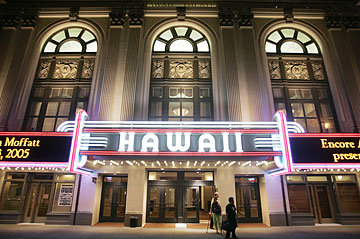
STAR-BULLETIN FILE PHOTO
Hawaii Theatre, Oct. 18, 2005.
|
|

